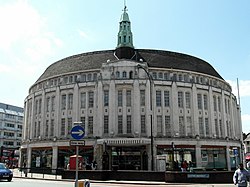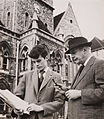Lewisham Town Hall
| Lewisham Town Hall | |
|
Kent | |
|---|---|
 Lewisham Town Hall | |
| Location | |
| Grid reference: | TQ37647366 |
| Location: | 51°26’43"N, 0°1’15"W |
| Town: | Lewisham |
| History | |
| Address: | Catford Road |
| Built 1932 | |
| By: | Bradshaw Gass & Hope |
| Art Deco | |
| Information | |
Lewisham Town Hall is a municipal building in Catford Road, Lewisham, Kent. The oldest part of the facility, the curved municipal offices, is a Grade II listed building.[1]
History
The building has its origins in a local vestry hall for which the foundation stone was laid by the Chairman of the Board, James Brooker, on 27 July 1874.[2] It designed by George Elkington in the Gothic style which was completed in 1875.[3] It was extended to accommodate the headquarters of the new Metropolitan Borough of Lewisham in 1901.[3]
A curved structure, designed by Bradshaw Gass & Hope in the Art Deco|Art Deco style, which incorporated a concert hall, was built to the east of the vestry hall and completed in 1932.[1]
During the Second World War, an inquiry into the circumstances surrounding the bombing of Sandhurst Road School by enemy aircraft on 20 January 1943, which resulted in deaths of 38 children and 6 staff, was held in the town hall.[4]
A further extension in the form of a long curved block of offices to the north west was designed by M. H. Forward in the Modernist style and built in the late 1950s and early 1960s.[3]
A local activist, William Horton, led a petition which was supported by John Betjeman to save the original vestry hall in the early 1960s.[5] However, in 1968, following on from the creation of the Lewisham Council in 1965, the vestry hall was demolished to make way for a "Civic Suite". The latter was designed by A Sutton and completed in 1971.[3] Meanwhile, on the south side of Catford Road, St Laurence's Church was also demolished in 1968 to make way for an additional office block for council use known as St Laurence's House.[6]
A statue by Gerda Rubinstein entitled Pensive Girl was unveiled outside the building in 1992.[7]
-
The old vestry hall c. 1900
-
John Betjeman reads William Horton's petition to save the vestry hall
-
The "Civic Suite" completed in 1971
References
- ↑ 1.0 1.1 National Heritage List 1253065: Lewisham Theatre and Department of Environmental Service (Grade II listing)
- ↑ Foundation stone lying in Manor House Gardens
- ↑ 3.0 3.1 3.2 3.3 'London's Town Halls' (Historic England), page 151
- ↑ Local History and Archives Centre, Lewisham. "Second World War Air Raid, Catford Sandhurst School". Lewisham War Memorials. London Borough of Lewisham. http://lewishamwarmemorials.wikidot.com/incident:world-war-ii-sandhurst-school-catford. Retrieved 24 March 2011.
- ↑ "The Faded Grandeur Of London's Old Town Halls". The Londonist. 30 April 2013. https://londonist.com/2013/04/the-faded-grandeur-of-londons-old-town-halls. Retrieved 8 May 2020.
- ↑ "St Laurence's Church, Catford Road, Catford, c. 1905". Ideal Homes. http://www.ideal-homes.org.uk/lewisham/assets/galleries/catford/st-laurences-church. Retrieved 25 April 2020.
- ↑ Cartiere, Cameron; Zebracki, Martin (2015). The Everyday Practice of Public Art: Art, Space, and Social Inclusion. Routleadge. p. 173. ISBN 978-1138829213. https://books.google.co.uk/books?id=9c34CgAAQBAJ&pg=PA173&lpg=.


